Campus Library 50th anniversary exhibition
In 2012, the campus Library celebrated 50 years since the official opening of the Library building on 8th October 1962. To mark the occasion, this exhibition charts the birth and development of the University Library.
Library beginnings
In 1949, a year before the opening of the University College, the build-up of the Library began without a book or a shelf, but with one Librarian. Stanley Stewart was the first member of staff to be appointed after the Principal (Lord Lindsay) and Registrar (Dr Jenkins). At a time of post-war shortages, and with only a modest budget, Stewart began to scour the UK for books. As well as searching second-hand bookshops, he combed the basements of public and university libraries in search of unwanted duplicates. He was even known to check obituary notices in the hope of acquiring the libraries of deceased academics.
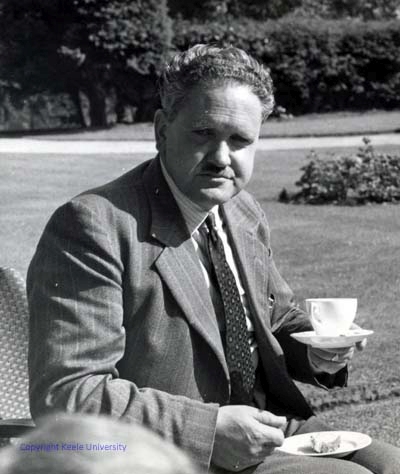
Birthplace of the University
The first accommodation was a small office in Aqueduct Street, Stoke, shared by the Principal, Registrar and Librarian. A notice-board outside stated, “University College of North Staffordshire (Proposed)”. When the Librarian arrived, he was told by the Registrar “There’s not much room. Whatever you do, don’t bring any books in”. Thereafter, accommodation was provided in ex-army huts near Keele Hall.
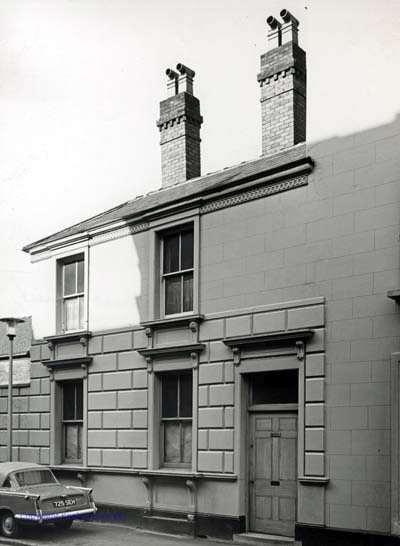
Moving books
A month before the first intake of 150 students were due to arrive at the College in October 1950, books were transported from campus huts to rooms in Keele Hall using a perambulator - a Lindsay family heirloom.
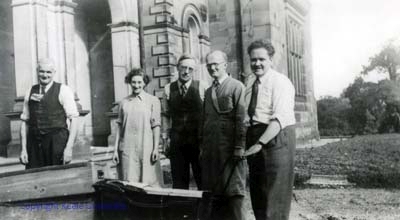
In Keele Hall
The first room in Keele Hall to be made available was the former Sneyd library, which became the nucleus of an ever-expanding Library. Approximately 20,000 volumes were provided for the first students.
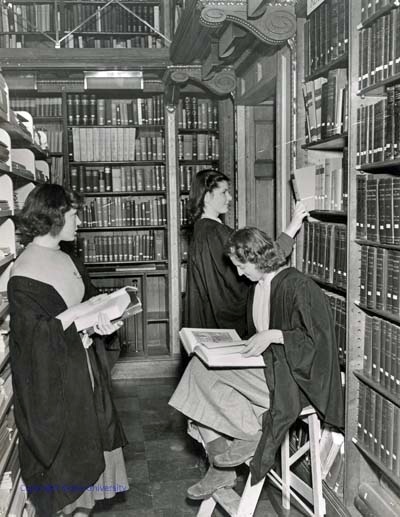
By the summer of 1952 there was a stock of 40,000 volumes. Lord Lindsay’s personal library was donated and over 10,000 volumes were transferred from LePlay House upon the dissolution of the Institute of Sociology.
By 1954, the annual report recorded possession of 70,000 volumes, of which almost half were catalogued.
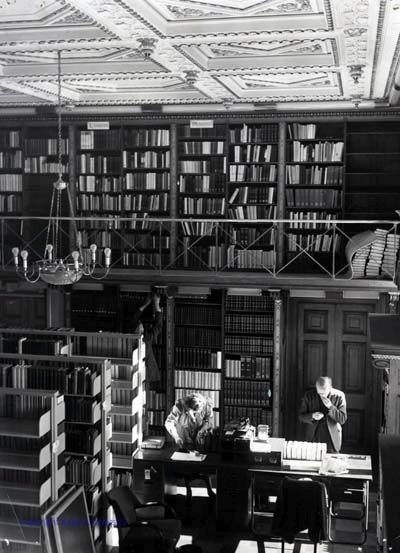
Library staff 1955
Top row: Alan Attwood (Photographer); Lorna Hazard (Inter-Library Loans); Rosemary Day and Anne Wesley (Library Assistants); Nancy Nicholson (Cataloguer); Kathleen Johnson (Library Assistant); Pam Grange (Typist).
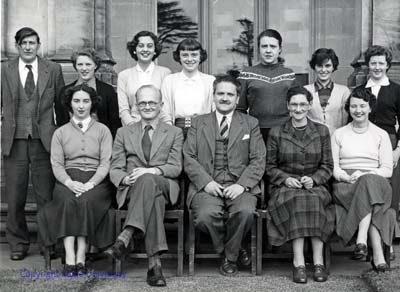
Bottom row: Brenda Gilbert (Circulation Control); Bill Mason (Binding); Stanley Stewart (Librarian), Joan Friedman (Chief Cataloguer); Rita Holland.
Charles Sarolea Library
In 1954, at a cost of £1,348, the University College purchased over 120,000 items from the library of Charles Sarolea, who had passed away the previous year. Sarolea, a bibliomaniac, had been a Belgian Diplomat and Professor of French at the University of Edinburgh. The collection certainly represented rich pickings for a new University College - it contained a rich variety of subjects in numerous languages, including texts from the fifteenth and sixteenth centuries.
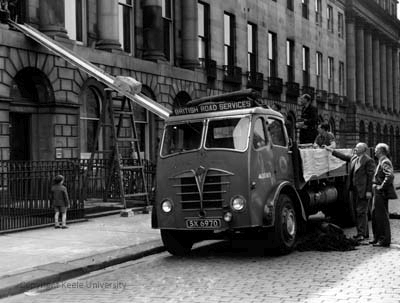
It cost a further £447 and took two weeks to move over 100 tons of books from Sarolea’s home at 21 and 22 Royal Terrace, Edinburgh, down to Brunswick Methodist school rooms in Newcastle-under-Lyme.
Book storage
By 1955, Keele had accumulated a book stock of 180,000 volumes, growing at a rate of 5,000 volumes a year. To meet the considerable rate of increase, more and more accommodation was required, which caused inconvenience to many College departments. In Stanley Stewart’s words: “the Senate was deprived of the Senate Room and the Principal was twice dislodged from his room. In all, some 24 rooms were eventually taken over and books had to be housed most inconveniently in every conceivable corner, along corridors and in various cupboards outside the confines of the Library.”
When the lease on the Methodist school rooms expired in 1957, uncatalogued books were transferred to almost 15,000 feet of shelving at the disused Madeley brickworks. This building continued to serve as a store well into the 1970s.
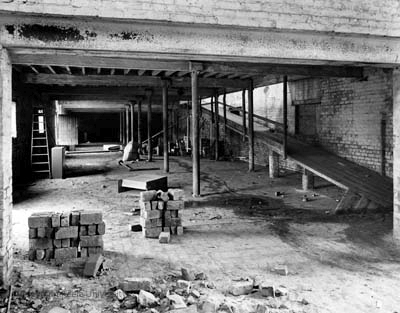
Plans for a new library
The need for a new building became imperative and discussions began in 1955. Sir Howard Robertson was appointed architect in 1956 and a brief was prepared in 1957. In November 1959 the University Grants Committee gave permission for stage 1 and 2 work to commence at an approximate cost of £290,000, with an addition of £48,000 for furniture and equipment. Building work began in 1960 and the second stage followed immediately.
When this photograph was taken in 1956, the proposed Library site was still covered by residential huts originally built for troops stationed at Keele during World War II.
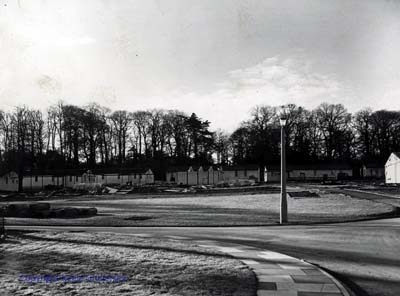
Building stages 1 and 2
The first two stages of building work progressed throughout 1960 and 1961.
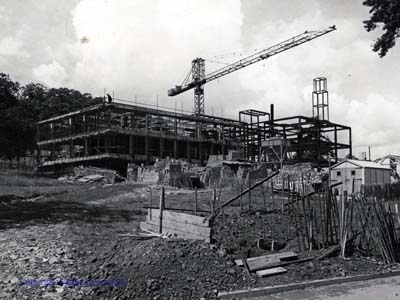
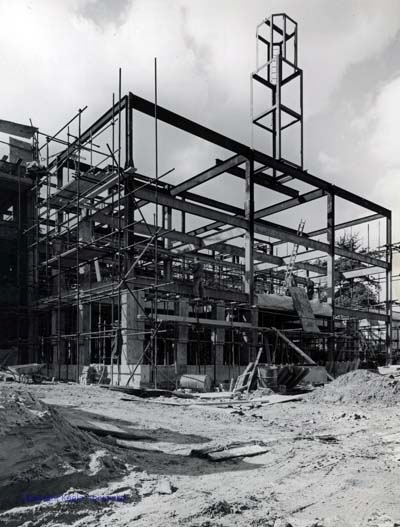
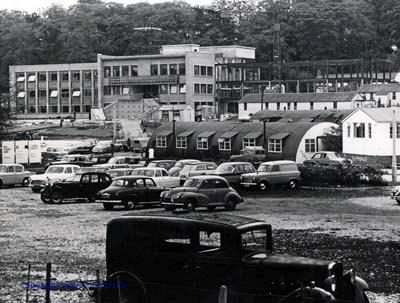
Topping out
Upon completion of the first two stages of the Library building, a “topping out” ceremony was held on the roof. Left to right: Mike Paffard, Tony Flew, Arthur Tough, John Hodgkinson, Stanley Stewart, W A C Stewart, unidentified, unidentified, Patrick Day.
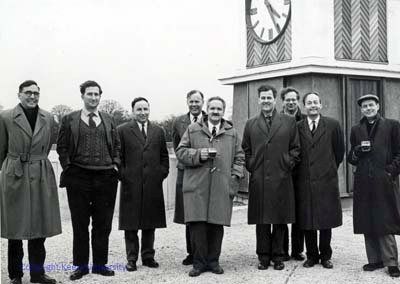
Offical opening
Staff began working in the building in September 1961, though the formal opening of the Library wasn’t until Monday 8th October 1962 (by which time the College had been granted University status). Sir Sydney Roberts, former Vice-Chancellor of the University of Cambridge and President of the Library Association, officiated the opening attended by some 200 guests, comprising 53 librarians, 34 donors and friends, 13 architects and contractors, 36 Library staff and 46 Council, Senate and University members.
At this stage the Library had a capacity of approximately 200,000 volumes and over 300 readers.
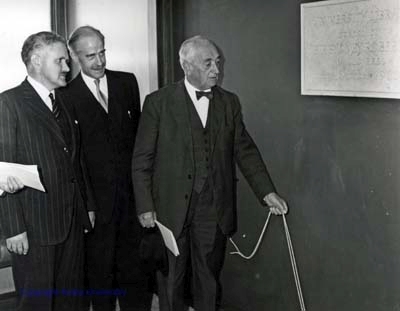
Building stages 3 and 4
The third and fourth stages of construction began in 1964 and were completed in the summer of 1966.
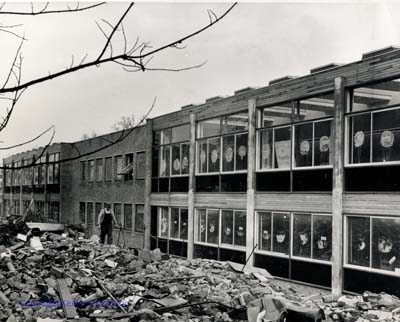
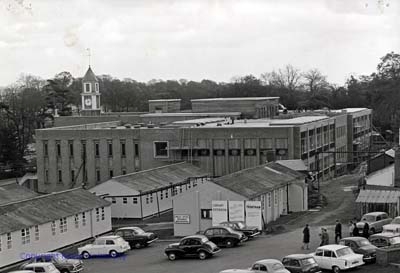
A place to study
All stages of the building were completed on time and cost £549,200, which was less than the rigid limitations imposed by the University Grants Committee. The Library could now provide accommodation for over 600,000 volumes and 750 readers, at a time when the student population was little over 1,000.
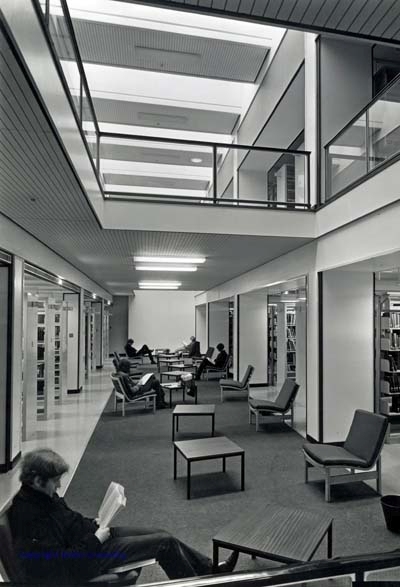
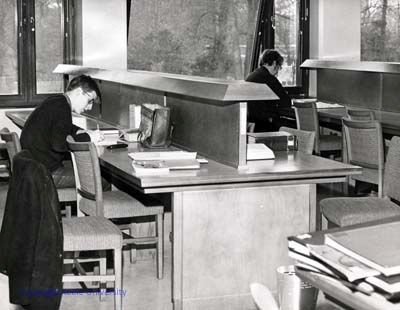
Central location
The Library building occupies a central and commanding site on the campus. Designed by the eminent architect Sir Howard Robertson, it cannot be labelled with any particular style of architecture. The clock tower, a distinctive feature, was incorporated at the request of the University to provide a general campus timepiece. The overall height of the building was limited by the need for anti-subsidence measures which involved special foundation work and slip-joints in certain areas.
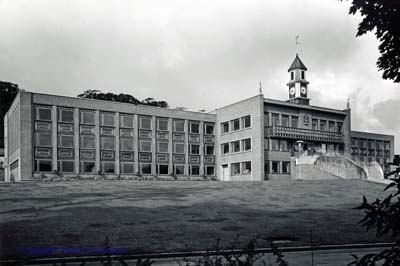
So there is no truth in the old canard that “the library is sinking”!
Special Collections and Archives
In 1957, as a result of Stanley Stewart’s careful negotiations, the Cheshire historian and antiquary Raymond Richards sold his entire collection of manuscripts to the College. The collection included the Sneyd family papers and several other significant family archives, as well as an important collection of medieval title deeds . Today, this collection and other archives are housed in the Library’s secure, temperature and humidity controlled stores. Material is available for consultation in the Archives Searchroom.
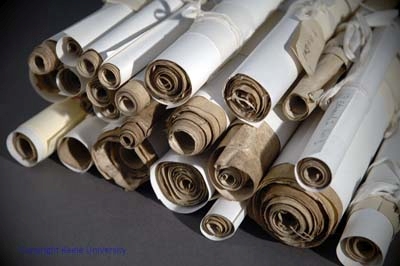
Short loan
Foundation year undergraduates were required to attend the same course of lectures and so the provision of multiple copies of texts on short-term loan was essential. A grant of £20,000 from the Nuffield Foundation made it possible to stock a “library within the library” to meet the particular needs of first year undergraduates. Known as the Nuffield Library for over 40 years, from 2005 it became known simply as Short Loan. It has recently been refurbished to provide a fresh up-to-date group study area.
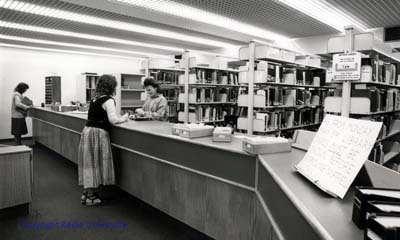
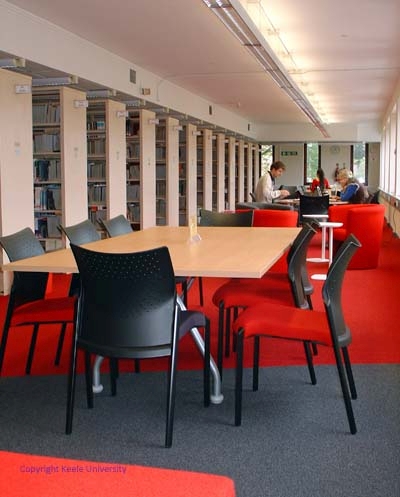
Cataloguing department
The former Cataloguing Department, still in the same location today, but amalgamated with ordering under the name Library Support Services. Many processes are now automated or outsourced, resulting in a much faster turnaround of orders.
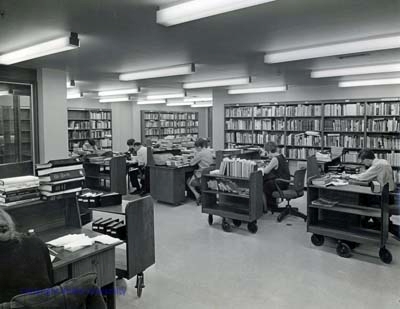
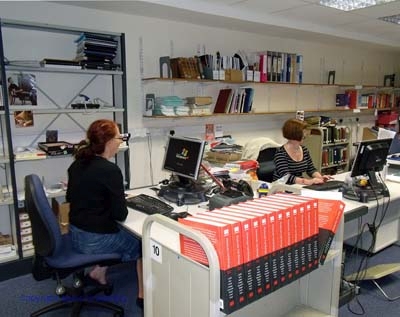
The Library catalogue was in sheaf form and housed in custom-made ‘pigeon holes’. It wasn’t until the early 1990s that the catalogue and circulation system became automated.
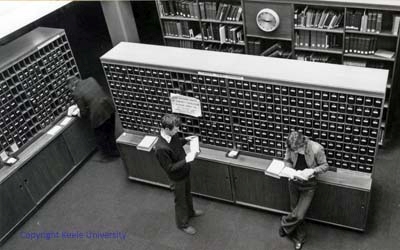
Library counter
The Library counter has changed both its look and its location over the decades. We still have a counter, but over 85% of our loans are issued on our self-service machines.
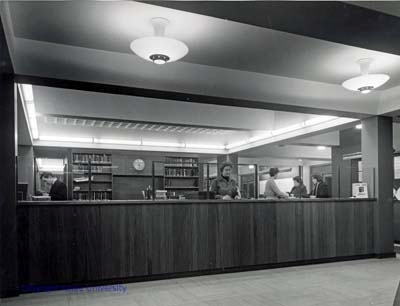
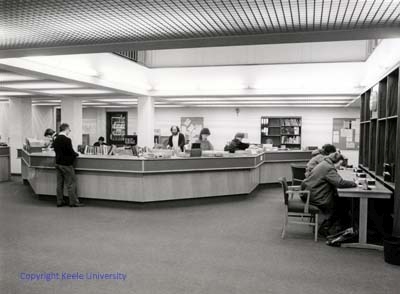
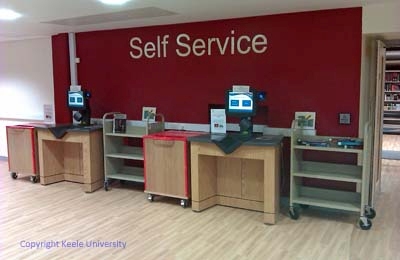
Not just a Library
The Library initially housed a photographic department, reprographics section and a bindery.
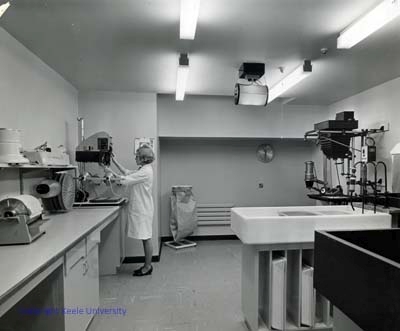
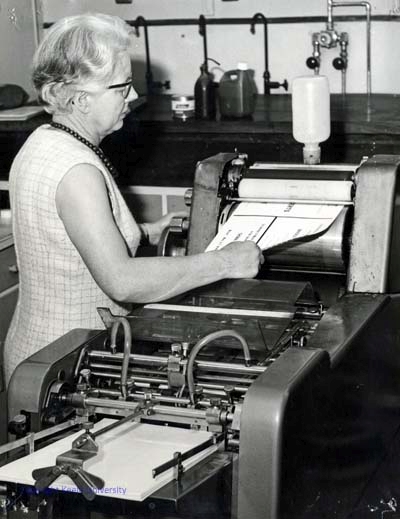
A Students’ Bookshop was incorporated into the new Library building with independent access from outside.
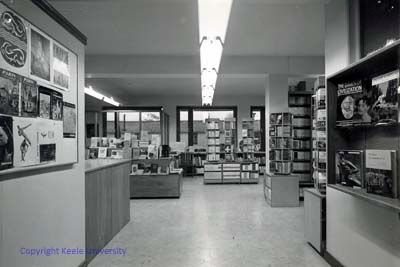
Financial stringency and friends
By 1968, the rising costs of books and journals and the effects of devaluation saw a curtailment in the Library’s purchasing programme. To increase contact and cooperation between the Library and teaching departments, a system of subject specialism among senior graduate Library staff was initiated in 1967, though the planned increase in staff to match the Library’s expanding services was not allowed.
In 1971, the deteriorating financial position caused concerned teaching staff to form a group of Friends of Keele University Library to provide resources in cash and kind to supplement official sources. Dr Francis Celoria was founder and chairman of the group responsible for many book purchases. By 1980, most members had left Keele and the group was wound up.
Growth and change
In 1971 the gloom was somewhat lightened when additional money was made available from UGC supplementary grants. Also, a capital grant of £20,000 from the Appeal Fund was allocated for the purchase of research material. By 1971, stock figures had risen to 282,000, with a new accession rate of 14,000.
In 1975 the Library saw a 23% increase in use. With the provision of special funds, an eighteen month accelerated programme to clear the Sarolea Collection from the store at Madeley gathered momentum.
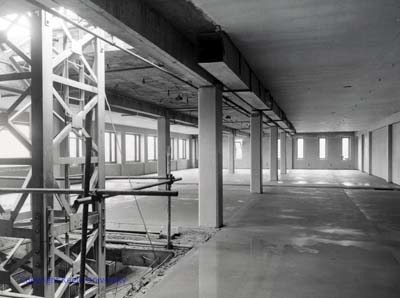
The Library wings were designed to be flexible for adaptation, having no internal structural walls and with full load-bearing floors throughout. This foresight and generosity of space has allowed the building to be adapted over the decades to meet changing Higher Education agendas.
Education Library
In 1984, building alterations allowed the separate Education Library in the Chancellor’s Building to move to the main Library. Initially, Education occupied its own section, but stock was later interspersed with the main Library. Between 1988 and 1995, the Library was also home to the University Careers Service.
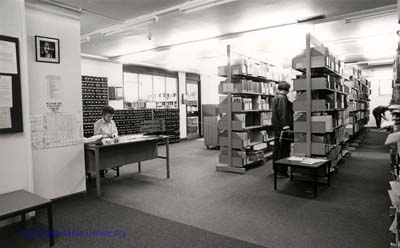
Information Services
Perhaps the biggest shift came in 1993, when the Library converged with the Computer Centre and became Keele Information Services. The building was adapted to house KIS staff offices, server rooms, PC labs and an IT helpdesk. Although IT Services moved to a different Administrative Directorate in 2005, they remain in the Library building.
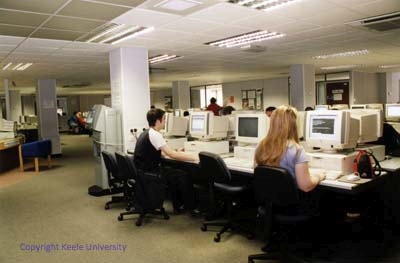
The Library in the 21st century
The last 12 years have continued to see considerable change in how the Library looks and how it is used. A refurbishment of the central areas took place in 2006/7 that enabled the building to accommodate group study areas for the first time, wireless connectivity was introduced along with self-service options for users. The building was also open for longer, with 24 hour opening first making an appearance in 2008/9.
This coming year the Library will be open 24/7 throughout semester. The Library is a far busier environment than when it was first built and remains very much at the centre of the University.
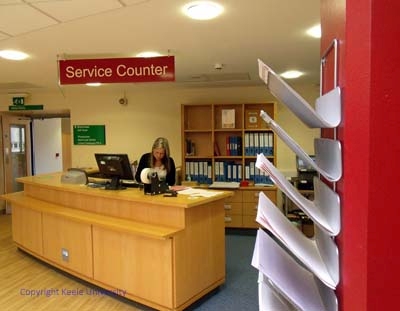
Vital statistics
In the last academic year, the Library added some 14,000 print items to stock. This equates to 1.4 new books per user, at a time when the sector average is just 0.9.
See how our current statistics compare to 50 years ago…
Number of volumes in Library: 1962 - 200,000, 2012 - 590,000*
Library study spaces: 1962 - 300, 2012 - 850
Number of people entering Library: 1962 - 98,000, 2012 - 711,000
* As well as more than 300,000 ebooks.

